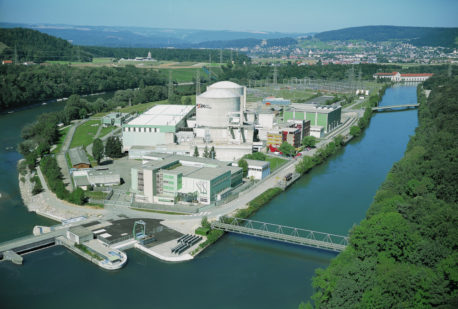Liquid radioactive releases from Swiss nuclear facilities are at a low level
Liquid radioactive substances from Swiss nuclear facilities that reach the Aare and Rhine rivers are well below the officially defined emission limits. This is the conclusion reached by ENSI in the Eighth Swiss Report on the Implementation of the OSPAR Recommendation on Radioactive Discharges.

To protect the environment, Swiss nuclear facilities use the best available technology and best environmental practice in the treatment of radioactive wastewater, a position corroborated by ENSI in its latest report on the implementation of the OSPAR recommendation.
The Radioactive Substances Committee of the OSPAR Commission confirmed the Swiss result in its annual meeting, at which the Swiss report was presented and discussed. Switzerland’s eighth report has now been published by the OSPAR Commission.
The OSPAR Convention is an agreement drawn up for the protection of the marine environment of the North-East Atlantic. ENSI is the Swiss representative on the Radioactive Substances Committee. As a contracting party to OSPAR, Switzerland is periodically due to compile and submit an implementation report in addition to the annual reporting on Swiss liquid radioactive releases.
What does OSPAR stand for?
Within the framework of the OSPAR Convention, 15 European governments and the EU cooperate to protect the marine environment of the North-East Atlantic. OSPAR is a partial amalgamation of “Oslo” and “Paris”: OSPAR started in 1972 with the Oslo Convention against dumping in the North Sea, the Arctic Ocean and the North Atlantic. With the Paris Convention of 1974, the convention was expanded to include land-based marine pollution sources and the offshore industry. In 1992, the two conventions were unified, updated and expanded to form the OSPAR Convention.
Cooperation between contracting parties is coordinated within the framework of the OSPAR Commission. This is supported by five main committees. Switzerland has been a contracting party to the Convention since 1998 and ENSI is the Swiss representative on the Radioactive Substances Committee (Radioactive Substances Committee).
Releases have been continuously reduced over the last 20 years
Switzerland’s eighth OSPAR report covers the period from 2015 to 2020. As part of its assessment, the OSPAR recommendation uses indicators for discharges, environmental effects and radiation doses to the public.
The liquid radioactive substances that reach the Aare and Rhine rivers are well below the maximum permitted release rates and activity concentrations specified in the operating licences (release limits). The total quantity of discharges (excluding tritium) has demonstrated a downward trend over the past two decades due to technical and business management reasons. Moreover, the target value of less than one gigabecquerel (without tritium) per year has been continuously achieved by all nuclear facilities since 2016.
Control measures for protection of the environment and the population
Important control measures for the protection of people and the environment include:
- Monitoring direct radiation,
- Monitoring radioactivity in the vicinity of nuclear facilities,
- Limiting releases and
- Calculating the dose due to the emissions that have occurred.
According to Art. 112 of the Radiological Protection Ordinance low activity radioactive substances can be released via exhaust air into the atmosphere and via wastewater into surface water (emissions). As the licensing authority, the Federal Department of the Environment, Transport, Energy and Communications (DETEC) specifies the maximum permissible release rates and activity concentrations. In addition, ENSI, as the regulatory authority, defines the so-called environmental monitoring programme in facility-specific release regulations.
In Switzerland, operators of the nuclear facilities are responsible for controlling their releases. In turn, ENSI monitors that this is done correctly and that the release regulations are complied with. For this purpose, ENSI carries out its own measurements and inspections: from the control of measuring systems to comparative measurements of samples taken from wastewater and exhaust systems.
Monitoring of radioactive releases from nuclear facilities and their impact on the environment
Releases of radioactive substances from nuclear facilities via wastewater and exhaust air are continuously monitored in order to protect both the environment and the population. ENSI publishes the respective emission data of the nuclear power plants on a monthly basis on its website (in German).
In addition, there are immission measurements. Amongst other things, ENSI operates a measuring network for automatic monitoring of dose rates in the vicinity of the nuclear power plants (MADUK). ENSI reports on the results of its oversight in the area of radiation measurements and environmental monitoring for the Swiss nuclear facilities in its annual Radiation Protection Report (in German). In addition, all the results of environmental monitoring (not just for nuclear facilities) are documented in the annual report “Environmental Radioactivity and Radiation Exposure In Switzerland” (in German) compiled by the Federal Office of Public Health (FOPH).

